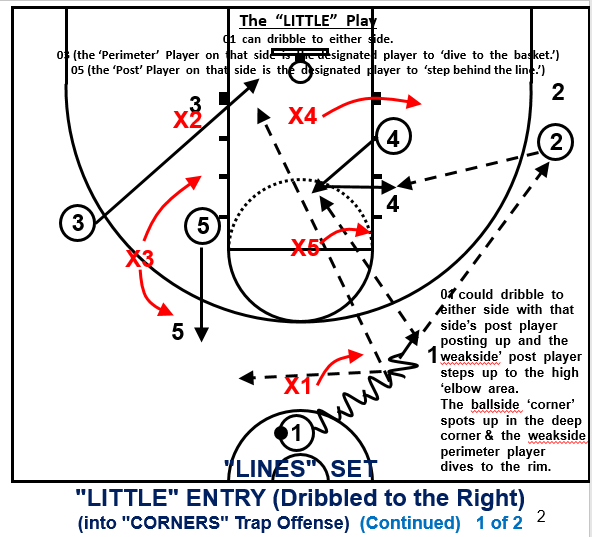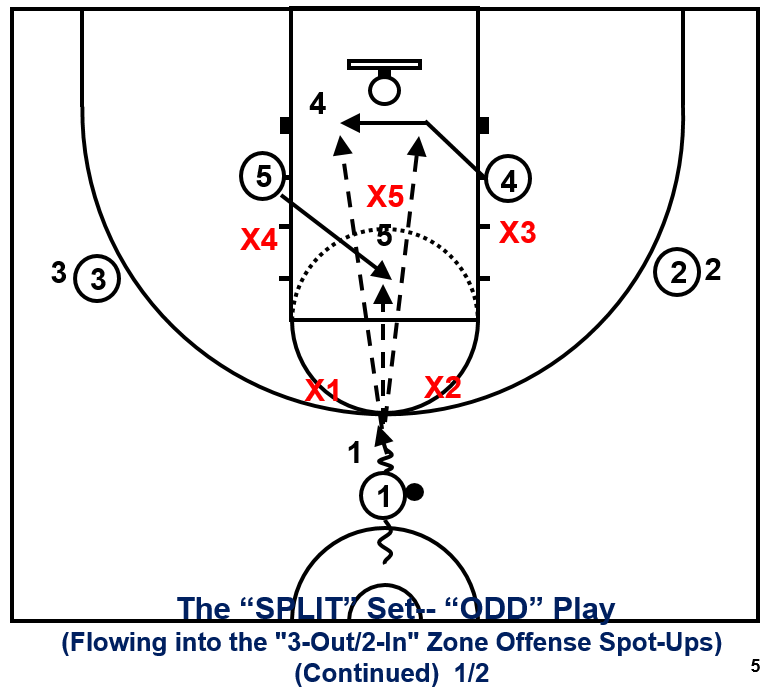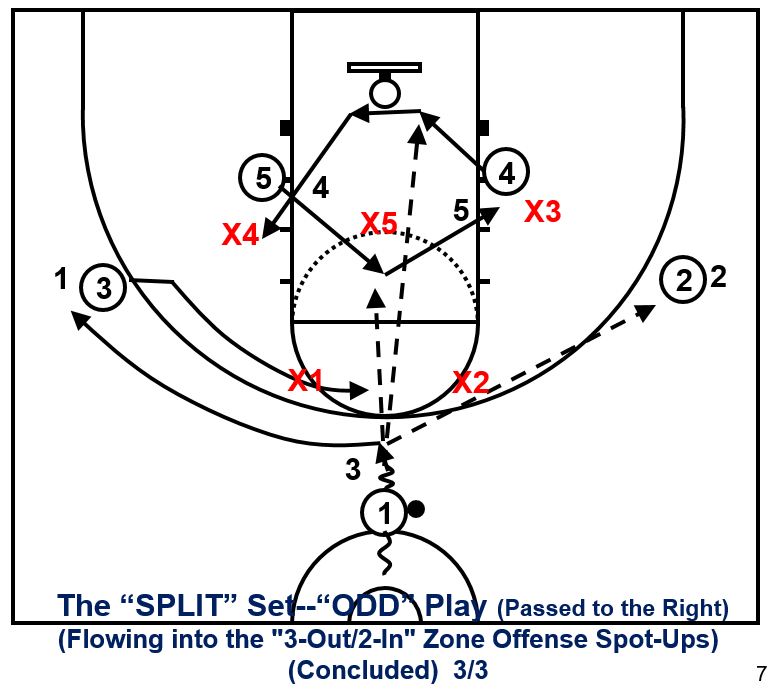The “LITTLE” entry dribbled towards the ‘low post’ side should have 01 again withstand the defensive double-team & specially ‘read’ X4 on the baseline & X3 on the new weakside wing. If X4 ‘shades’ out towards 02 in the ‘deep corner,’ 01 should look (& pass the ball) to the ‘small’ player making the diagonal cut to the rim–03. X3 would have to diagonally drop down to cover 03. If X3 drops to prevent the inside ‘lob pass’ to 03, then 05 should be open behind the ‘3 pt.’ line out on top. If 05 can handle the ball & shoot the ‘3’ & if 03 can be an effective inside shot scorer, the “LITTLE” play is an excellent play.

With the ball dribbled to the ‘low post’ side (right) in the “LITTLE” play, 01 has one inside shot look (to 03) & a possible ‘3 pt.’ shot (for 05). On the new ballside on the ‘low post’ side, 01 has two more balanced looks—that is an inside look to 04 and a ‘3 pt.’ look to 02. These three plays always have balanced threats with both an inside threat & a ‘ 3 pt.’ threat on both sides of the court. If these entries do not produce points, all 3 entries will position all five players into the proper “CORNERS” spot-up locations, so that the offense can quickly transition to the “CORNERS” Offense.

The “ODD” play out of the “SPLIT” Set is almost identical to the “Even” play, except 05 now makes the ‘duck-in cut’ into the dotted circle area & 04 is now the post player that makes the ‘lob route’ to the basket.
If neither post player receives the inside pass from 01, both post players then make ‘gap cuts’ to the mid-post block opposite of where they started.
If 01 makes the pass to either 03 or to 02, 01 then should exchange with the opposite wing. All five offensive players are now in the “3-Out/2-In” Spot-Ups to continue attacking the zone defense.

01 makes his ‘gap dribble,’ to draw both zone wing players towards the ball. 01 looks inside first, but if 01 makes the pass to either 03 or to 02, 01 then should exchange with the opposite wing. If 03 & 02 align in the “deep wing” areas, either X1 or X2 would have a longer slide to reach the ball. If it is known that the zone’s backline is to take the first pass, then 03 & 02 should align at the FT line extended (to force X4 & X3 to have a longer slide.) If 03 does not have an open shot, he then should look to hit 04 posting up, to make a skip pass to 01 or to reverse the ball to 02. Ball reversal ends the “ODD” play & then begins the “3-Out/2-In” Zone ‘Spot-Ups’ to continue the offensive attack.

After 01’s ‘gap dribble,’ 01 could make a bounce pass to 05 on his ‘duck-in’ cut; or 01 could make a lob pass to 04 now behind the zone on his cut to the basket. If no inside passes are made, this time 01 could make the ‘wing pass’ to 02. After the pass to 02, 03 steps up & over to set a flare-screen so 01 can make a flare-cut to the new weakside wing. 02 then looks inside to 05 who has cut across the lane to post up on the new ballside block. 02 could have a wide open 3 point shot or he could skip the ball to 01. If the ball is reversed to 03, all five offensive players are in the ‘Spot-Ups’ to begin the execution of the “3-Out/2-In” Zone Continuity Offense.

01 make the same ‘gap dribble’ that again initiates both post players’ respective cuts.
But when the ball is instead passed to 02, the “TAILS” play dictates that 05 is the post player that empties out AWAY from the stack, while 04 returns to the stack side to post up. This means that 03 is the wing player that sets the flare-screen for 01 to use as he flare-cuts to the new weakside wing area. Again, If no scores develop, all five players will end up in the “3-Out/2-In” Zone Continuity spot-ups, to maintain the constant attack on the opposition’s zone defense.

John Kimble is a respected basketball coach, author, and educator with extensive coaching experience.
©2025 Copyright All right reserved .